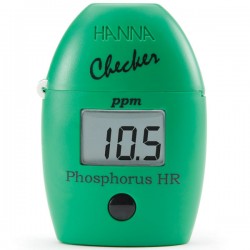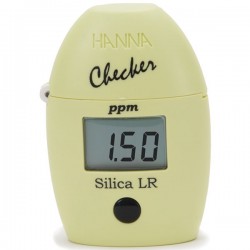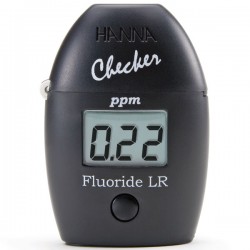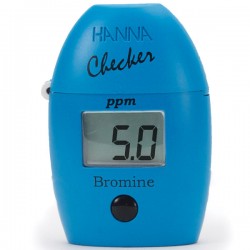

HI-83305-02 Multi-parameter Photometer & pH Meter for Boilers and Cooling towers
HI-83305-02
One meter can be used for both photometric and pH measurements. The meter has 30 different programmed methods measuring 18 key water quality parameters.
HI-83305-02 Boiler and Cooling Tower Photometer with pH digital input
Advanced optical system - Unparalleled performance from a benchtop photometer
One meter can be used for both photometric and pH measurements. The meter has 30 different programmed methods measuring 18 key water quality parameters and also offers an absorbance measurement mode for performance verification and for users who would like to develop their own concentration versus absorbance curves. To save valuable benchtop space, the HI-83305 doubles as a professional pH meter with its digital pH/temperature electrode input. Suitable for use in boiling and cooling tower applications, parameters specific to boiling and cooling towers include oxygen scavengers and silica which are important for maintaining equipment.
To save valuable laboratory benchtop space, the HI-83305 doubles as a professional pH meter with its digital pH/temperature electrode input.
This photometer features an innovative optical system that uses LEDs, narrow band interference filters, a focusing lens, plus a silicon photodetector for absorbance measurement and a reference detector to maintain a consistent light source which ensures accurate and repeatable photometric readings every time.
Specifically designed for use with boilers and cooling towers, the HI-83305 is a comprehensive way to maintain precise water conditions in systems. Problems such as corrosion, deposition, and microbial growth can occur if these key parameters, such as oxygen scavengers and silica, aren't maintained. Oxygen scavengers are added to remove residual dissolved oxygen in boiler feed water that can cause corrosion in a steam generating plant. It is important that levels of oxygen scavengers be routinely checked to prevent against corrosion and ensure that equipment is working efficiently. Boiler water maintenance is necessary to prevent or control deposit formation as seen with silica. Silica contamination can reduce system efficiency and increase maintenance of equipment due to scaling.
A digital pH electrode input allows the user to measure pH by a traditional glass electrode. The digital pH electrode has a built-in microchip within the probe that stores all of the calibration information. Having the calibration information stored in the probe allows for hot swapping of pH electrodes without having to recalibrate. All pH measurements are automatically compensated for temperature variations with a built-in thermistor located in the tip of the sensing bulb for fast and accurate temperature measurement.
The HI-83305 offers an absorbance measuring mode that allows for CAL Check standards to be used to validate the performance of the system. The absorbance mode allows the user to select one of the five wavelengths of light (420 nm, 466 nm, 525 nm, 575 nm, and 610 nm) to measure and plot their own concentration versus absorbance mode. This is useful for users with their own chemical method and for educators to teach the concept of absorbance by using the Beer-Lambert Law.
Two USB ports are provided for transferring data to a flash drive or computer and to use as a power source for the meter. For added convenience and portability, the meter can also operate on an internal 3.7 VDC Lithium-polymer rechargeable battery.
Key features:
- Backlit 128 x 64 Pixel Graphic Liquid Crystal Display
- Built-in Reaction Timer for Photometric Measurements
- Absorbance mode - concentration versus absorbance
- Units of Measurement plus chemical form displayed
- Result conversion at the touch of a button
- Cuvette cover
- pH and temperature measurement with a single probe
- Good Laboratory Practice (GLP) - track calibration information including date, time, buffers used, offset and slope for traceability
- pH CAL Check alerts user to potential problems during the calibration process
- Data Logging - Up to 1000 photometric and pH readings can be stored.
- Logged readings can be quickly and easily transferred to a flash drive or to a PC. Data is exported as a .CSV file for use with spreadsheet programs.
- Battery Status Indicator
- Error Messages
High Efficiency LED Light Source
An LED light source offers superior performance compared to a tungsten lamp. LEDs have a much higher luminous efficiency, providing more light while using less power. They also produce very little heat, which could otherwise affect the optical components and electronic stability. LEDs are available in a wide array of wavelengths, whereas tungsten lamps are supposed to be white light (all wavelengths of visible light) but actually have a poor blue/violet light output.
High Quality Narrow Band Interference Filters
The narrow band interference filter not only ensure greater wavelength accuracy (+/- 1 nm) but are extremely efficient. The filters used allow up to 95% of the light from the LED to be transmitted as compared to other filters that are only 75% efficient. The higher efficiency allows for a brighter, stronger light source. The end result is higher measurement stability and less wavelength error.
Reference Detector for a Stable Light Source
A beam splitter is used as part of the internal reference system of the HI-83300 photometer. The reference detector compensates for any drift due to power fluctuations or ambient temperature changes. Now you can rely on a stable source of light between your blank (zero) measurement and sample measurement.
Large Cuvette Size
The sample cell of the HI-83308 fits a round, glass cuvette with a 25 mm path length. Along with the advanced optical components, the larger size of the cuvette greatly reduces errors in rotation from the indexing mark of the cuvettes. The relatively long path length of the sample cuvette allows the light to pass through more of the sample solution, ensuring accurate measurements even in low absorbance samples.
Focusing Lens for Greater Light Yield
Adding a focusing lens to the optical path allows for the collection of all of the light that exits the cuvette and focusing the light on the silicon photo detector. This novel approach to photometric measurements cancels the errors from imperfections and scratches present in the glass cuvette eliminating the need to index the cuvette.
Read More
| Input Channels | 1 pH electrode input and 5 photometer wavelengths | |
| pH Electrode | Digital pH electrode (not included) | |
| Logging type | Log on demand with user name and sample ID optional input | |
| Logging Memory | 1000 readings | |
| Connectivity | USB-A host for flash drive; micro-USB-B for power and computer connectivity | |
| GLP | Calibration data for connected pH electrode | |
| Display | 128 x 64 pixel LCD with backlight | |
| Battery Type/Life | 3.7 VDC Li-polymer rechargeable battery/ >500 photometric measurements or 50 hours of continuous pH measurement | |
| Power supply | 5 VDC USB 2.0 power adapter with USB-A to micro-USB-B cable (included) | |
| Environment | 0 to 50.0°C (32 to 122.0°F; 0 to 95% RH, non-condensing | |
| Dimensions | 206 x 177 x 97mm (8.1 x 7.0 x 3.8") | |
| Weight | 1.0 kg (2.2lbs) | |
| Photometer/Colorimeter Light Source | 5 LEDs with 420nm, 466nm, 525nm, 575nm, and 610nm narrow band interference filters | |
| Photometer/Colorimeter Light Detector | Silicon Photodetector | |
| Bandpass filter Bandwidth | 8nm | |
| Bandpass filter wavelength accuracy | +-1nm | |
| Cuvette Type | Round, 24.6mm | |
| Number of Methods | 128 Max | |
| Ordering Information | HI-83305 is supplied with sample cuvettes and caps (x4), cloth for wiping cuvettes, USB to micro USB cable connector, power adapter and instruction manual. |
ALUMINIUM
| Aluminium Range | 0.00 to 1.00 mg/L (as Al3+) | |
| Aluminium Resolution | 0.01 mg/L | |
| Aluminium Accuracy | ±0.04 mg/L ±4% of reading | |
| Aluminium Method | Adaptation of the aluminon method |
AMMONIA
| Ammonia Range | Low Range: 0.00 to 3.00 mg/L (as NH3-N) Medium Range: 0.00 to 10.00 mg/L (as NH3-N) High Range: 0.0 to 100.0 mg/L (as NH3-N) | |
| Ammonia Resolution | 0.01 mg/L; 0.1 mg/L | |
| Ammonia Accuracy | Low Range: ±0.04 mg/L ±4% of reading Medium Range: ±0.05 mg/L ±5% of reading High range: ±0.5 mg/L ±5% of reading at 25 °C | |
| Ammonia Method | Adaptation of the ASTM Manual of Water and Environmental Technology, D1426-92, Nessler method |
BROMINE
| Bromine Range | 0.00 to 8.00 mg/L (as Br2) | |
| Bromine Resolution | 0.01 mg/L | |
| Bromine Accuracy | ±0.08 mg/L ±3% of reading | |
| Bromine Method | Adaptation of the Standard Methods for the Examination of Water and Wastewater, 18th edition, DPD method. |
CHLORINE DIOXIDE
| Chlorine Dioxide Range | 0.00 to 2.00 mg/L (as ClO2) | |
| Chlorine Dioxide Resolution | 0.01 mg/L | |
| Chlorine Dioxide Accuracy | ±0.10 mg/L ±5% of reading | |
| Chlorine Dioxide Method | Adaptation of the Chlorophenol Red method. |
CHLORINE
| Free Chlorine Range | 0.00 to 5.00 mg/L (as Cl2) | |
| Free Chlorine Resolution | 0.01 mg/L | |
| Free Chlorine Accuracy | ±0.03 mg/L ±3% of reading | |
| Total Chlorine Range | 0.00 to 5.00 mg/L (as Cl2) | |
| Total Chlorine Resolution | 0.01 mg/L | |
| Total Chlorine Accuracy | ±0.03 mg/L ±3% of reading | |
| Chlorine Method | Adaptation of the EPA 330.5 DPD method Free Chlorine (ULR) & Total Chlorine (UHR): Adaptation of the Standard Methods for Examination of Water and Wastewater, 20th edition, 4500-Cl |
CHROMIUM, HEXAVALENT
| Chromium, Hexavalent Range | Low Range: 0 to 300 μg/L (as Cr6+) High Range: 0 to 1000 μg/L (as Cr6+) | |
| Chromium, Hexavalent Resolution | 1 μg/L | |
| Chromium, Hexavalent Accuracy | Low Range: ±1 μg/L ±4% of reading High Range: ±5 μg/L ±4% of reading | |
| Chromium, Hexavalent Method | Adaptation of the ASTM Manual of Water and Environmental Technology, D1687-92, Diphenylcarbohydrazide method. |
COPPER
| Copper Range | Low Range: 0.000 to 1.500 mg/L (as Cu2+) High range: 0.00 to 5.00 mg/L (as Cu2+) | |
| Copper Resolution | 0.001 mg/L; 0.01 mg/L | |
| Copper Accuracy | Low Range: ±0.01 mg/L ±5% of reading High Range ±0.02 mg/L ±4% of reading | |
| Copper Method | Adaptation of the EPA bicinchoninate method |
HYDRAZINE
| Hydrazine Range | 0 to 400 μg/L (as N2H4) | |
| Hydrazine Resolution | 1 μg/L | |
| Hydrazine Accuracy | ±4% of full scale reading | |
| Hydrazine Method | Adaptation of the ASTM Manual of Water and Environmental Technology, method D1385-88, p-Dimethylaminobenzaldehyde method |
IRON
| Iron Range | Low Range: 0.000 to 1.600 mg/L (as Fe) High Range: 0.00 to 5.00 mg/L (as Fe) | |
| Iron Resolution | 0.001 mg/L; 0.01 mg/L | |
| Iron Accuracy | Low Range: ±0.01 mg/L ±8% of reading High Range: ±0.04 mg/L ±2% of reading | |
| Iron Method | Low Range: Adaptation of the TPTZ Method High Range: Adaptation of the EPA Phenanthroline method 315B, for natural and treated waters |
MOLYBDENUM
| Molybdenum Range | 0.0 to 40.0 mg/L (as Mo6+) | |
| Molybdenum Resolution | 0.1 mg/L | |
| Molybdenum Accuracy | ±0.3 mg/L ±5% of reading | |
| Molybdenum Method | Adaptation of the mercaptoacetic acid method |
NITRATE
| Nitrate Range | 0.0 to 30.0 mg/L (as NO3--N) | |
| Nitrate Resolution | 0.1 mg/L | |
| Nitrate Accuracy | ±0.5 mg/L ±10% of reading | |
| Nitrate Method | Adaptation of the Cadmium Reduction Method |
NITRITE
| Nitrite Range | Freshwater Low Range: 0 to 600 μg/L (as NO2--N) High Range: 0 to 150 mg/L (as NO2-) Marine Ultra Low Range: 0 to 30.0mg/L (as NO3--N) | |
| Nitrite Resolution | Freshwater: 1 μg/L; 1 mg/L Marine: 0.1 mg/L | |
| Nitrite Accuracy | Freshwater Low Range: ±20 μg/L ±4% of reading High Range: ±4 mg/L ±4% of reading Marine: ±0.5 mg/L ±10% of reading | |
| Nitrite Method | Adaptation of the EPA Diazotization method 354.1; HR Ferrous Sulphate |
OXYGEN, DISSOLVED
| Oxygen, Dissolved Range | 0.0 to 10.0 mg/L (as O2) | |
| Oxygen, Dissolved Resolution | 0.1 mg/L | |
| Oxygen, Dissolved Accuracy | ±0.4 mg/L ±3% of reading | |
| Oxygen, Dissolved Method | Adaptation of the Standard Methods for the Examination of Water and Wastewater, 18th edition, Azide modified Winkler method |
OXYGEN, SCAVENGER
| Oxygen, Scavenger Range | 0 to 1000 μg/L (as DEHA) 0.00 to 1.50 mg/L (as Carbohydrazide) 0.00 to 2.50 mg/L (as Hydroquinone) 0.00 to 4.50 mg/L (as ISO-ascorbic acid) | |
| Oxygen, Scavenger Resolution | 1 μg/L (DEHA); 0.01 mg/L | |
| Oxygen, Scavenger Accuracy | ±5 μg/L ±5% of reading | |
| Oxygen, Scavenger Method | Adaptation of the iron reduction method |
pH
| pH Range | Photometer: 6.5 to 8.5 pH pH electrode: -2.00 to 16.00 pH | |
| pH Resolution | Photometer: 0.1 pH pH electrode: 0.1 pH | |
| pH Accuracy | Photometer: ±0.1 pH pH electrode: ±0.01 pH | |
| pH Calibration | Automatic one or two point calibration with one set of standard buffers available (4.01, 6.86, 7.01, 9.18, 10.01) | |
| pH Temperature Compensation | Automatic (-5.0 to 100.0 oC; 23.0 to 212.0 oF); limits reduced based on the pH electrode used | |
| pH CAL Check (electrode diagnostics) | clean electrode and check buffer/check probe displayed during calibration | |
| pH Method | Photometer: phenol red | |
| pH-mV Range | ±1000 mV | |
| pH-mV Resolution | 0.1 mV | |
| pH-mV Accuracy | ±0.2 mV |
PHOSPHATE
| Phosphate Range | Freshwater Low Range: 0.00 to 2.50 mg/L (as PO43-) High range: 0.0 to 30.0 mg/L (as PO43-) | |
| Phosphate Resolution | Freshwater: 0.01 mg/L; 0.1 mg/L | |
| Phosphate Accuracy | Freshwater Low Range: ±0.04 mg/L ±4% of reading High Range: ±1 mg/L ±4% of reading | |
| Phosphate Method | Freshwater Low Range: Adaptation of the Ascorbic Acid method Freshwater High Range: Adaptation of the Standard Methods for the Examination of Water and Wastewater, 18th edition, Amino Acid method |
SILICA
| Silica Range | Low Range: 0.00 to 2.00 mg/L (as SiO2) High Range: 0 to 200 mg/L (as SiO2) | |
| Silica Resolution | 0.01 mg/L; 1 mg/L | |
| Silica Accuracy | Low Range: ±0.03 mg/L ±3% of reading High Range: ±1 mg/L ±5% of reading | |
| Silica Method | Low Range: Adaptation of the ASTM Manual of Water and Environmental Technology, D859, Heteropoly Molybdenum Blue method High Range: Adaptation of the USEPA Method 370.1 and Standard Method 4500-SiO2 |
ZINC
| Zinc Range | 0.00 to 3.00 mg/L (as Zn) | |
| Zinc Resolution | 0.01 mg/L | |
| Zinc Accuracy | ±0.03 mg/L ±3% of reading | |
| Zinc Method | Adaptation of the Standard Methods for the Examination of Water and Wastewater, 18th edition, Zincon method |
| REAGENTS | ||
| Aluminium | HI-93712-01 (100 tests); HI-93712-03 (300 tests) | |
| Ammonia HR, MR & LR | HR - HI-93733-01 (100 tests); HI-93733-03 (300 tests); MR - HI-93715-01 (100 tests); HI-93715-03 (300 tests); LR - HI-93700-01 (100 tests); HI-93700-03 (300 tests) | |
| Bromine | HI-93716-01 (100 tests); HI-93716-03 (300 tests) | |
| Chlorine Dioxide | Reagents: HI-93738-01 (100 tests); HI-93738-03 (300 tests) | |
| Chlorine - Free | Free Chlorine Reagents: HI-93701-01 (100 tests); HI-93701-03 (300 tests); HI-93701-F (liquid) (300 tests) | |
| Chlorine Total | HI-93711-01 (100 tests); HI-93711-03 (300 tests); HI-93711-T (300 tests liquid) Chlorine, Total ULR: HI-95761-01 (100 tests); HI-95761-03 (300 tests) | |
| Chromium VI – HR & LR | HR - HI-93723-01 (100 tests); HI-93723-03 (300 tests) LR - HI-93749-01 (100 tests); HI-93749-03 (300 tests) | |
| Copper – HR & LR | HR - HI-93702-01 (100 tests); HI-93702-03 (300 tests) LR - HI-95747-01 (100 tests); HI-95747-03 (300 tests) | |
| Hydrazine | HI-93704-01 (100 tests); HI-93704-03 (300 tests) | |
| Iron – HR & LR | HR - HI-93721-01 (100 tests); HI-93721-03 (300 tests) LR - HI-93746-01 (100 tests); HI-93746-03 (300 tests) | |
| Molybdenum | HI-93730-01 (100 tests); HI-93730-03 (300 tests) | |
| Nitrate | HI-93728-01 (100 tests); HI-93728-03 (300 tests) | |
| Nitrite – HR & LR | HR - HI-93708-01 (100 tests); HI-93708-03 (300 tests) LR - HI-93707-01 (100 tests); HI-93707-03 (300 tests) | |
| Oxygen, Dissolved (DO) | HI-93732-01 (100 tests); HI-93732-03 (300 tests) | |
| pH | HI-93710-01 (100 tests); HI-93710-03 (300 tests) | |
| Phosphate - HR & LR | HR - HI-93717-01 (100 tests); HI-93717-03 (300 tests) LR - HI-93713-01 (100 tests); HI-93713-03 (300 tests) | |
| Silica – HR & LR | HR - HI-96770-01 (100 tests); HI-96770-03 (300 tests) LR - HI-93705-01 (100 tests); HI-93705-03 (300 tests) | |
| Zinc | HI-93731-01 (100 tests); HI-93731-03 (300 tests) |


















